To purchase or rent our MP4 videos, visit our Digital Padesky Store
Action-Based Learning (sku: dACTION)
InSession Action-Based Learning with Behavioral Experiments – Full Color MP4 video. (length: 87 minutes)
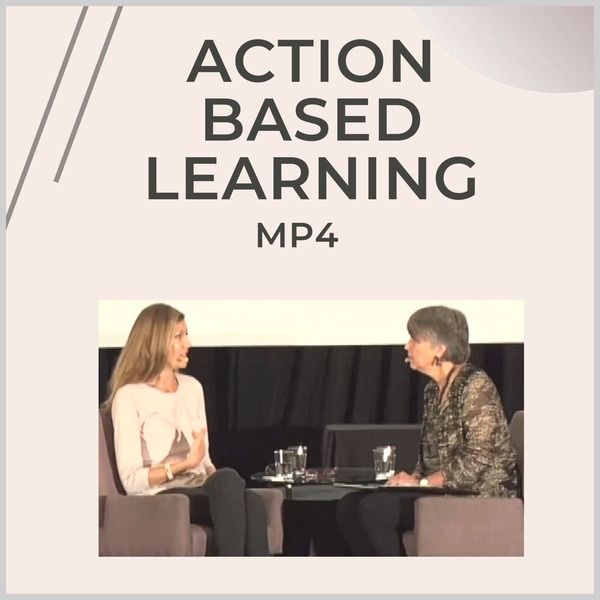
A common issue many therapists face is discovering the client did not complete their homework assignment.
This video demonstrates important steps in setting up a good behavioral experiment and discusses the benefits of using Socratic dialogue to debrief the outcomes of experiments.
Filmed at a conference, this live, spontaneous, and unedited clinical demonstration features Christine A. Padesky, PhD conducting a therapy session with “Jennifer” (role played by therapist Jennifer O’Connor, PhD). Jennifer reports extreme difficulty saying no to people and finds she accommodates other people’s needs instead of her own.
In their previous session, Dr Padesky and Jennifer had decided that her behavioral experiment would be to say no to a friend’s request to do things for her. This session begins with Jennifer revealing she did not do the behavioral experiment she had planned to do between sessions.
Padesky demonstrates
- Debriefing a behavioral experiment
- How to setup and conduct behavioral experiments within a session. Padesky suggests this is often more therapeutic because there is the opportunity to immediately debrief the experience with the client.
- How to use Socratic dialogue and processes of guided discovery to maximize client learning from experiments done in session.
DISCUSSANT COMMENTS: by William Miller, creator and founder of Motivational Interviewing.
BRIEF QUESTION & ANSWER SEGMENT
The last 20 minutes consists of audience questions and insightful answers from Dr. Padesky and role play participant Jennifer that flush out sophisticated elements and nuances of the demonstration.
PRODUCT REVIEW: “I am a Beck Institute CBT certified clinician. What I love most about Dr. Padesky’s seminars is her desire to bring difficult points to clients in a simple way. In the Seminar: In-Session Action-Based Learning with Behavioral Experiments (vACTION) I liked my desire to do behavioral experiments in the session. This causes my personal interest and benefit to clients. The day after watching the seminar, I even randomly turn on the option to use Behavioral Experiments in sessions with my clients. This is an improved experience.
I recommend to all!”
Thought Record (sku: dVATR)
Testing Automatic Thoughts With Thought Records – Full color MP4 video (length: 69 minutes)
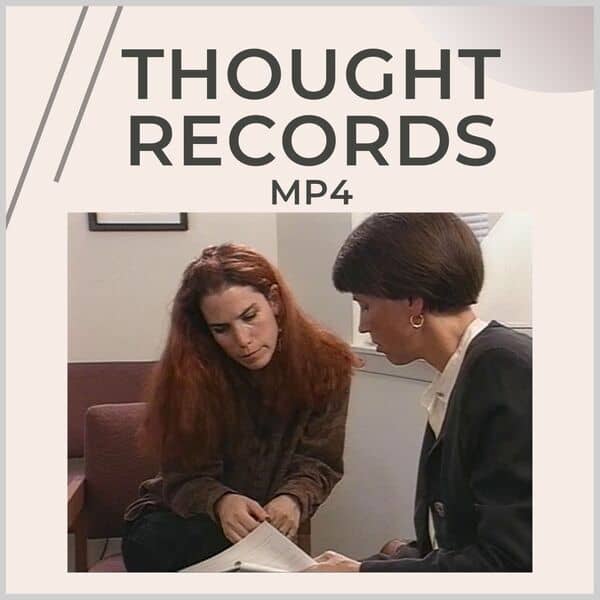
Christine Padesky helps a depressed client explore her “hot thoughts” using the 7 column thought record. Watch an entire therapy session with narrative commentary about each section of the thought record. This session is a vivid demonstration of the integration of technique with a collaborative therapy alliance.
Viewers comment on the helpfulness of this video to demonstrate the pacing and timing of a therapy session when using a thought record. It has been especially helpful to see how empathic and conversational the therapy session can be even while teaching skills in a structured way.
Includes close-up shots of client and therapist notes.
MP4 video with times (1:09:39)
Titles (30 sec with music)
Permissions & Use Advisement (00:54 with music)
- Beliefs & Interventions (00:00 to 4:46)
- Situations, Mood, Thoughts (4:46 to 13:39)
- “Hot” Thoughts (13:39 to 21:28)
- Supporting Evidence (21:28 to 30:03)
- Non‐supporting Evidence (30:03 to 40:58)
- Search for Hidden Evidence (40:58 to 49:50)
- Alternative / Balanced Thoughts (49:50 to 1:01:30)
- Summary & Feedback (1:01:30 to 1:08:40)
- End Credits (1:08:40 to 1:09:39 with music)
VATR PRODUCT REVIEW Excellent Demonstration (submitted by a Clinical Psychologist ) “I am an advanced CBT therapist and trainer. This video is an excellent demonstration of how a therapist can elicit automatic thoughts and teach cognitive restructuring skills for a depressed patient using the format in the book Mind Over Mood. Dr. Padesky is very directive while at the same time she highlights many general therapeutic skills such as empathy, patience, two way communication, collaboration, and affirmation of patient qualities. She also explains some key concepts related to cognitive therapy such as automatic thoughts, underlying assumptions, and core beliefs; and provides insightful commentary about responding to challenges related to working with depressed patients. I highly recommend this video for any therapist learning cognitive restructuring.”
New Core Beliefs (sku: dVBEL)
Constructing New Core Beliefs – Full color MP4 video (length: 60 minutes)

Dr. Padesky and a volunteer therapist conduct a role-play demonstration of a woman who has suffered from recurrent depression and low self-esteem who would like to develop a new core belief: “I am wonderful.”
The primary methods used to strengthen new core beliefs are demonstrated including use of a continuum and assignment of a core belief log.
In narrative comments before and after the demonstration, Dr. Padesky highlights the importance of the therapeutic alliance and the benefits of using written “shoulder-to-shoulder” methods instead of “eyeball-to-eyeball” dialogues when constructing new core beliefs.
Since it is difficult for clients to imagine new core beliefs, this client’s skepticism and cognitive “blanks” are quite typical.
This video illustrates how to engage a client and evoke curiosity regarding the possibility of new core beliefs even when the client is doubtful that this approach will help.
dVBEL MP4 video with times (1:00:35)
Titles (30 sec with music)
Permissions & Use Advisement (00:54 with music)
- Core Beliefs (00:00 to 5:28)
- Session Overview (5:28 to 10:12)
- Identify Core Beliefs (10:12 to 16:16)
- Continuum Ratings (16:16 to 21:23)
- Continuum Criteria (21:23 to 28:38)
- Core Belief Log Rationale (28:38 to 34:56)
- Navigate Roadblocks (34:56 to 48:17)
- Assign Core Belief Log (48:17 to 54:03)
- Feedback & Summary (54:03 to 59:34)
- End Credits (59:34 to 1:00:35 with music)
VBEL PRODUCT REVIEW
Submitted by Frank M. Dattilio, PhD, ABPP, (Department of Psychiatry, Harvard Medical School and University of Pennsylvania School of Medicine)
“Outstanding Educational Training Resources: These are outstanding educational training resources that will be helpful to students and practitioners of all levels. I have found them to be a great resource in my clinical work and will also use them in my didactic lectures with students. I highly recommend them.”
Case Conceptualization (sku: dVCON)
Collaborative Case Conceptualization – Full Color MP4 video (length: approximate 60 minutes)
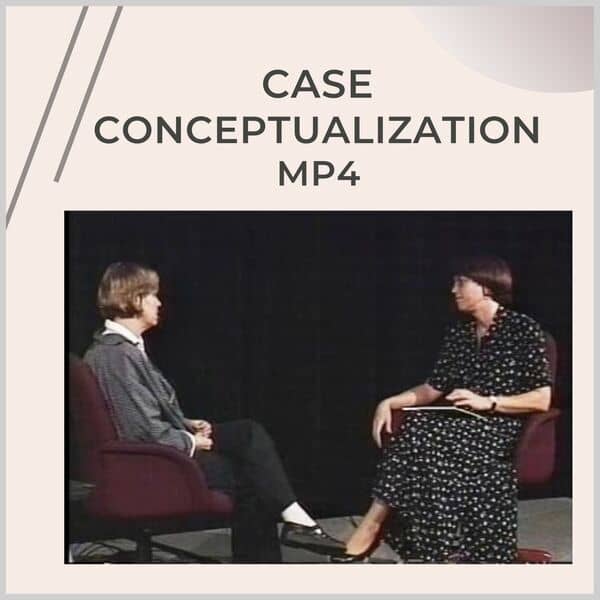
Christine Padesky in one session, illustrates collaboration with a client to develop a case conceptualization that includes significant: developmental history, core beliefs, rules, behavioral strategies, positive benefits and negative consequences. Also includes identification of new beliefs and rules to support behavior change.
Our therapist viewers comment how much they can identify with this client’s issue of taking on too much work. They appreciate seeing how much can be accomplished in a single session.
Includes use of a split screen. Allows the viewer to see the therapist-client interaction up close.
dVCON MP4 video with times (57:52)
Titles (30 sec with music)
Permissions & Use Advisement (00:54 with music)
- Presenting Issues (00: to 10:33)
- Cultural Context (10:33 to 19:33)
- Beliefs, Rules & Strategies (19:33 to 26:39)
- Summary, Benefits & Costs (26:39 to 30:45)
- Goals (30:45 to 36:12)
- Written Conceptualization (36:12 to 40:44)
- Conceptualization & Goals (40:44 to 53:53)
- New Rules to Reach Goals (53:53 to 53:53)
- Summary & Feedback (53:53 to 57:17)
- End Credits (57:17 to 57:52 with music)
Panic Disorder (sku: dVPAN)
Cognitive Therapy for Panic Disorder – Full Color MP4 video (length: 50 minutes)
- Have you read about the success of cognitive therapy with panic disorder but are not quite sure what happens in a session?
- Do some of your panic clients tell you that they know they are not in danger during a panic attack – but only intellectually and only when it is over?
- Do you then struggle with helping them learn that this is true even when they are having a panic attack?
- Are you hesitant to induce panic symptoms during a session, not knowing how you will feel or what the client might say or do?
- Learn why it is impossible for a client to faint when they are having a true panic attack.
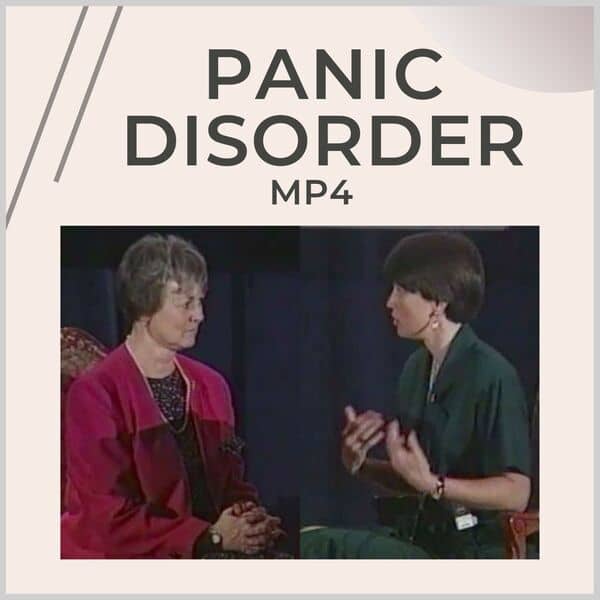
Viewers of this full session tape will see how the therapist and client work together to identify the elements of the client’s panic attacks.
Observe how the therapist uses guided discovery to help the client understand the cognitive model of panic. See how the therapist induces sensations and uses a series of specific questions to guide discovery of a believable explanation for the client’s panic-related sensations.
Distinguish the important diagnostic rule outs for panic disorder as well as the critical factors to consider before doing an in-session induction of panic sensations.
Specific questions, summaries and procedures are clearly modeled that demonstrate the cognitive therapy protocol for panic disorder. Christine Padesky demonstrates key stages:
- Therapist & client collaboratively identify elements of the client’s recent panic attack including sensations, thoughts and images, and catastrophic misinterpretations
- Client data is used to develop the cognitive model
- The therapist induces sensations which closely mimic a panic attack
- Therapist and client debrief the induction to help the client discover believable alternative explanations for the panic-related sensations
Viewers find this video extremely helpful in understanding how the induction of sensations paired with guided discovery helps the client develop meaningful alternative explanations for their panic sensations. Also, they comment on how quickly Dr. Padesky is able to form a positive therapeutic alliance through the use of humor and collaboration.
Includes close-up shots of therapist notes. Split screen work allows the viewer to see the therapist-client interaction up close.
dVPAN MP4 video with times (50:26)
Titles (30 sec with music)
Permissions & Use Advisement (00:54 with music)
- CBT Panic Disorder (00:00 to 4:27)
- Sensations & Thoughts (4:27 to 16:08)
- Panic Model (16:08 to 22:40)
- Induction Experiment (22:40 to 27:16)
- Debrief Experiment (27:16 to 35:49)
- Two Hypotheses (35:49 to 39:48)
- Treatment Plan (39:48 to 47:28)
- Homework Assignments (47:28 to 49:49)
- End Credits (49:49 to 50:26 with music)
Building Resilience with Strengths-Based CBT (sku: dVRES)
Building Resilience with Strengths-Based CBT – Full Color MP4 video (length: 63 minutes)
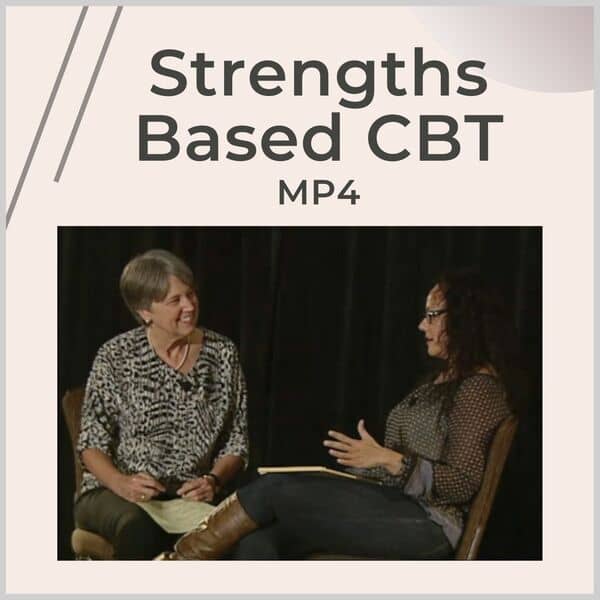
This video illustrates Strengths-Based CBT’s 4-step model to build resilience (Padesky & Mooney, 2012).
Important phases of the interview are highlighted with chapter titles. Each chapter title is paired with an audio voice over narration in which Padesky describes the therapy processes and strategies that viewers can look for in the next segment. Her narrative guidance helps make this DVD an excellent teaching tool for therapists who want to learn to foster client resilience.
Dr. Padesky begins the interview by asking about Suki’s difficulties and positive interests. Positive interests that are not directly linked to difficulties are prime areas where it is possible to observe client strengths and resilience in action. Suki is struggling with grief and wants to learn to be more resilient. She reports a variety of positive areas in her life (e.g, her affectionate relationship with her dogs, a daily blog she has been keeping for several years). She chooses to talk about her blog activities for this interview.
Step 1: SEARCH for Strengths – Padesky uses Socratic dialogue to help Suki uncover a variety of strengths that she relies on to maintain her blog.
Step 2: CONSTRUCT a Personal Model of Resilience (PMR) – Her identified strengths become integral to the PMR that Suki constructs.
Step 3: APPLY the PMR to a Problem Area – With Padesky’s guidance, Suki develops a behavioral experiment to investigate the impact her PMR might have on her grief process.
Step 4: PRACTICE Resilience – In the final chapters of the interview, viewers can observe how Padesky keeps Suki’s focus on remaining resilient in the face of grief, rather than trying to alleviate her grief. Viewers can observe how important it is to stay alert to client statements that suggest they want to eliminate the problem rather than practice staying resilient in the face of the problem.
While this interview focuses on our 4-step model to build resilience, this DVD also demonstrates many of the key elements of Strengths-Based CBT (SB-CBT). Viewers can see how a SB-CBT therapist maintains a focus on strengths, collaborates with the client to construct new beliefs and possibilities, relies on the client’s everyday experiences to construct models, and employs signature nonverbal methods of the approach such as smiling, silence and facial expressiveness.
REFERENCE: Padesky, C. A. & Mooney, K.A. (2012). Strengths-based Cognitive-Behavioural Therapy: A four-step model to build resilience. Clinical Psychology & Psychotherapy, 19 (4), 283-90. (reprint available from www.padesky.com/clinical-corner/publications)
dVRES MP4 video with times
- Identify Problems & Positive Interests
(00:00 to 06:07 includes intro with music) - Choosing a Positive Interest for Strengths Search (06:07 to 10:47)
- Identify Obstacles (10:47 to 15:19)
- STEP 1: SEARCH for Strengths (15:19 to 29:20)
- STEP 2: CONSTRUCT a Personal Model of Resilience (29:20 to 35:56)
- Set a Goal to be Resilient (35:56 to 44:10)
- STEP 3: APPLY PMR to a Problem (44:10 to 48:05)
- STEP 4: PRACTICE Resilience (48:05 to 1:02:50 includes end credits with music)
VRES PRODUCT REVIEWS
Licensed psychoterapist (CBT) (Freddy S): This video shows in an educational way how to work with patients where they can not offer as many sessions. I work in a health center and meet my patients between six to eight times. An important part of treatment is to improve the patient’s own strengths and skills that they use to feel better, so the patient will become their “own therapist.” This video shows you how can to do this. I am a licensed psychotherapist (CBT) in Sweden, Stockholm, who have worked for over ten years. I am also an expert in CBT for schizophrenia and also in this area, this is useful.
Building Resilience…By Fiona M: This is a very useful resource that I will apply clinically and show to my CBT post graduate students
Social Anxiety (sku: dVSA)
Cognitive Behavior Therapy for Social Anxiety – Full Color MP4 video (length: 54 minutes)
“Assertive Defense of the Self”
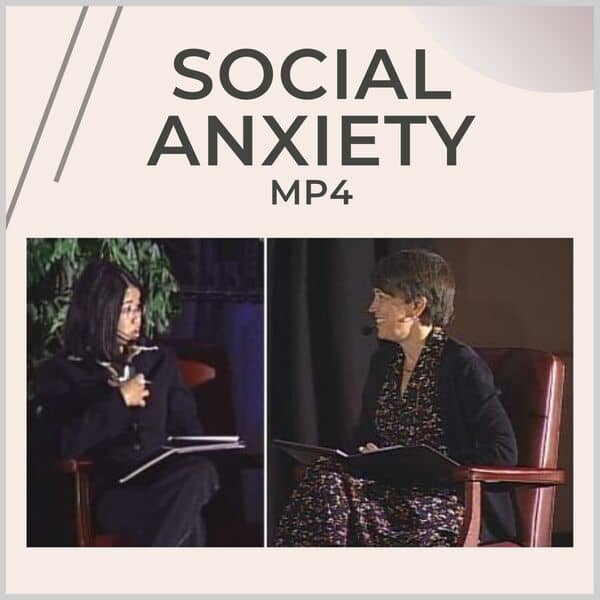
Dr. Christine Padesky presents her treatment rationale and demonstrates the CBT approach she developed in the 1990’s to treat social anxiety called “Assertive Defense of the Self.”
A young woman (Pooh) describes how she avoids certain social events and activities because she fears criticism from others. In the opening minutes of this DVD program, Pooh identifies her anxious thoughts and gives a brief history of her fears.
Via role play practice that Padesky debriefs using Socratic dialogue, Pooh begins to build her “Assertive Defense of the Self” repertoire and skills. Over the course of this single session Pooh gains confidence that she can cope with criticism.
Padesky emphasizes coping with criticism rather than testing out the belief that people are critical. This is because successful CBT protocols help people directly face their fears. If fear of criticism is central to social anxiety then it makes sense that learning to face and cope with criticism should be central to treatment.
Once Pooh gains confidence she can defend herself against criticism, she works with Padesky to devise a behavioral experiment to test her skills in the real world. She devises a challenging experiment that she hopes will elicit criticism from others. This experiment is based on the “Assertive Defense” philosophy that people with social anxiety should court criticism until their fears subside. Viewers will hear how Pooh and Padesky develop the experiment and how Pooh learns to view herself as “lucky” if she received criticism.
The end credits of the program include a photo of Pooh carrying out her behavioral experiment that she emailed to Dr. Padesky several weeks after this session was filmed. Our new Audio CD on Social Anxiety includes more follow-up information on these experiments! (SKU SANX)
dVSA MP4 video with times (53:24)
Titles (30 sec with music)
Permissions & Use Advisement (00:54 with music)
- Fear of Criticism (00:00 to 7:12)
- Relevant History (7:12 to 12:34)
- Treatment Rationale (12:34 to 15:57)
- Assertive Defense Setup (15:57 to 22:30)
- Practice Assertive Defense (22:30 to 28:21)
- Debrief Experiments (28:21 to 37:07)
- Seek Criticism (37:07 to 43:27)
- Practice “Gentle” Defense (43:27 to 46:35)
- Summary & Assignment (46:35 to 53:10)
- End Credits (53:10 to 53:24 with music)
VSA PRODUCT REVIEW
I Love “Assertive Defense of the Self” (submitted by Ellen Tobey Klass, PhD).
“I’m so glad you asked for my review. When I finished this segment (only one so far), I was so happy with what I’d viewed and learned, I wanted to tell people and couldn’t figure the venue. I’m an experienced CBT-er and have taken workshops and consulted with Dr. Padesky.
Things I loved: Seeing a seamless, interactive, and validating approach to in-session behavior rehearsal — as opposed to the didacticism one often sees (and lapses into). Very notable also, Dr. Padesky’s skillfully eliciting the client’s naturally-occurring positive viewpoints/self-statements — great for the client being able to use these and also great in the context of much negativity. I also loved how Dr. Padesky worked with the “client” – respectful, positive. At times, I could see Dr. Padesky pausing when the client said something not “CBT-correct”, such as perhaps a negative self-statement used as reinforcement. In the pause, I thought I saw Dr. Padesky figuring out how to respond to move the comment back to assertive defense of the self without conveying the client had done it wrong. And Dr. P did come up with things that did this. Plus, warmth and humor.
I’m using what I learned with a client who has a very difficult problem. We’ve been able to move much closer to in vivo practice, identify key issues, and find ways through some of them.
I’m so happy that I went to the source (this video), rather than keeping on relying on what others had told me about assertive defense of the self as a treatment strategy.”
Socratic Dialogue (sku: dVSOQ)
Guided Discovery Using Socratic Dialogue – Full Color MP4 video (length 44 minutes)
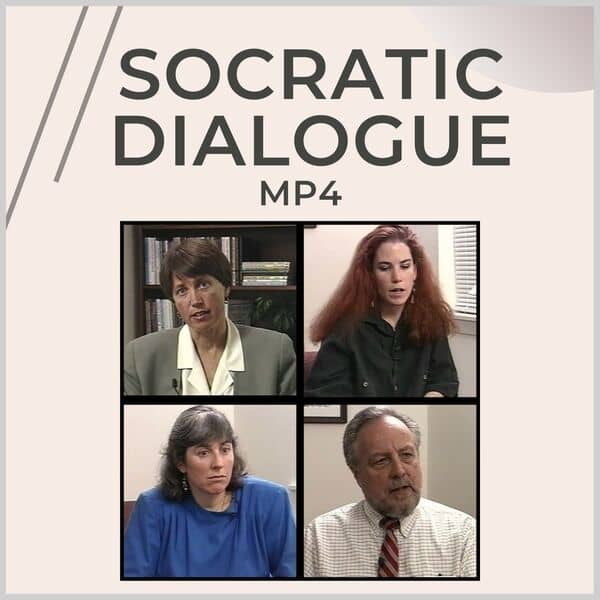
Dr. Padesky teaches the four stages of Socratic dialogue with three different clients: depressed, anxious, and angry.
Watch how she uses demonstrates the four stages to help clients uncover and re-evaluate key automatic thoughts:
- informational questions
- empathic listening
- summaries
- analytic / synthesizing questions
Her use of the Socratic process uncovers cognitions characteristic of each mood state.
Viewers comment that learning these four stages helps to demystify Socratic questioning.
Learn how to guide the client’s discovery instead of trying to change the client’s mind.
dVSOQ MP4 video with times (44:30)
Titles (30 sec with music)
Permissions & Use Advisement (00:54 with music)
- Socratic Dialogue (00:00 to 1:45)
- Four Stages (1:45 to 3:23)
- DEPRESSED Client: Sharon (3:23 to 16:11)
- Collaborative Empiricism (16:11 to 16:58)
- ANXIOUS Client: Jean (16:58 to 30:45)
- Advantages of Guided Discovery (30:45 to 31:44)
- ANGRY Client: Carl (31:44 to 43:05)
- Summary (43:05 to 43:33)
- End Credits (43:33 to 44:30 with music)
NEW Underlying Assumptions & Behavioral Experiments (sku: dVUAE)
Constructing NEW Underlying Assumptions & Behavioral Experiments – Full Color MP4 video (length: 55 minutes)

Dr. Padesky begins with a brief description of automatic thoughts, underlying assumptions, and core beliefs. She explains why recurrent problems are often best solved at the underlying assumption level.
Bob is a therapist struggling with ongoing procrastination regarding completion of case formulations at his clinic.
The session begins with a review of the underlying assumptions, identified prior to this interview, that maintain Bob’s procrastination
Together, she and Bob specify his goals for change and identify NEW underlying assumptions that would support these changes
Next, in collaboration with the therapist, Bob devises behavioral experiments to evaluate the utility of these NEW underlying assumptions
He makes specific predictions and identifies potential problems that need to be managed during his experiments
Dr. Padesky and Bob dialogue about the relative benefits of testing OLD and/or NEW beliefs.
This video illustrates how to identify NEW underlying assumptions and set up behavioral experiments based on the NEW assumptions.
As in her other videos, Dr. Padesky models a collaborative approach that promotes client curiosity, activity, and creativity.
For follow-up summaries of Bob’s behavioral experiments, visit our Clinical Corner
dVUAE MP4 video with times (44:31)
Titles (30 sec with music)
Permissions & Use Advisement (00:54 with music)
- Underlying Assumptions (00:00 to 5:09)
- Bob’s Conceptualization (5:09 to 9:14)
- Goals & NEW Beliefs (9:14 to 16:11)
- Strengths Perspective (16:11 to 28:04)
- NEW Underlying Assumptions (28:04 to 32:14)
- Behavioral Experiments (32:14 to 37:31)
- Bob’s Predictions (37:31 to 44:31)
- Feedback & Summary (44:31 to 52:43)
- End Credits (52:43 to 53:45 with music)
